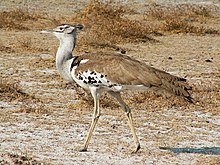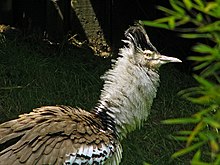Kori bustard
| Kori Bustard | |
|---|---|

| |
| Scientific classification | |
| Kingdom: | |
| Phylum: | |
| Class: | |
| Order: | |
| Family: | |
| Genus: | |
| Species: | A. kori
|
| Binomial name | |
| Ardeotis kori (Burchell, 1822)
| |
The Kori Bustard (Ardeotis kori) is a large bird native to Africa. It is a member of the bustard family. It may be the heaviest bird capable of flight, although this title may also belong to the similarly-dimensioned Great Bustard.

The Kori Bustard is mostly grey in color, with a black crest on its head and yellow legs. Kori Bustards are often found with bee-eaters riding on their backs as they stride through the grass. The bee-eaters make the most of their walking perch by hawking insects from the bustard's back that are disturbed by the bustard's wandering. This is a large and heavy bird, and avoids flying if possible. It spends most of its time on the ground, foraging for the seeds and lizards which make up most of its diet.

The male Kori Bustard averages at about 110 cm (3.6 ft) in length and stands 60–90 cm (2.0–3.0 ft) tall. An average male bird would weigh about 12.4 kg (27 lb), but exceptional birds may weigh over 20 kg (44 lb). A report exists of a 34 kg (75 lb) bird, but it is not verified and must be beheld with skepticism because it so much heavier than any other recorded weight for a Kori Bustard. The female Kori Bustard averages 5.7 kg (13 lb) and is usually 20% shorter than a male.
Like all bustards, Kori Bustards have polygynous breeding habits, where one male displays to attract several females and mates with them all. He then leaves the females to care for the young by themselves. The females build a nest on the ground and incubate the eggs, foregoing eating for days. When the chicks hatch, the mother brings them a steady stream of food, most of it soft so the chicks can eat it easily.
See also
- Sarus Crane - the tallest flying bird alive today
- Wandering Albatross - the largest wingspan among living birds
- Argentavis - the biggest flying bird ever to live
- Bee Hummingbird - smallest bird
References
- Template:IUCN2006 Database entry includes justification for why this species is of least concern
External links
- Kori Bustard videos, photos & sounds, The Internet Bird Collection
- [1], Smithsonian National Zoological Park Kori Bustard News
- [2], Smithsonian National Zoological Park Kori Bustard factsheet
- [3] Kori Bustard Species Survival Plan website

